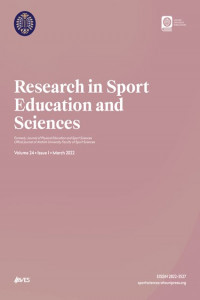YÜKSEK HIZ KOŞU YÜKLEMESİNİN BAZI VÜCUT HORMONLARININ ANİ DEĞİŞİMİNE ETKİSİ / THE EFFECT OF HIGH SPEED RACE LOAD ON SUDDEN CHANGES OF SOME HORMONES
Bu cal..ma, tek seferlik doruk yuklenmeli 60 metre surat ko.usunun, total testosteron,buyume hormonu, kortizol ve insulin hormonlar.n.n ani de.i.imi uzerine etkisini incelemek amac.ylaplanlanm..t.r. Cal..mam.z, 18-23 ya. aras., 22 sa.l.kl. erkek o.renci uzerinde gercekle.tirildi.Deneklere tek seferlik doruk yuklenmeli 60 metre surat ko.u testi uyguland.. Hormon olcumleri icindeneklerden ko.u oncesi ve sonras. ac kar.na kan ornekleri al.nd.. Elde edilen serumlardan hormonduzeyleri, elektrokemiluminesans yontemle olculdu. Ko.u oncesi serum total testosteron de.eri7,13�}2,13 ng/mL, buyume hormonu 1,92�}2,64 ng/mL, kortizol 15,67�}4,66 mg/dL, insulin 5,51�}2,94ƒÊIU/mL ve hematokrit 46,13�}2,11 (%) iken, ko.u sonras. serum total testosteron 7,53�}2,17 ng/mL,buyume hormonu 2,50�}3,45 ng/mL, kortizol 15,06�}4,46 mg/dL, insulin 4,41�}2,57 ƒÊIU/mL vehematokrit 48,62�}2,22 (%) olarak olculdu. Sonuc olarak; 60 metre surat ko.usu oncesi ve sonras.,serum total testosteron duzeylerinde anlaml. bir art.. (p<0.01), insulin duzeylerinde ise belirgin birazalma saptand. (p<0,001). Serum buyume hormonu duzeyleri ko.u sonras.nda artmakla beraber, buart.. anlaml. de.ildi (p>0,05). Serum kortizol duzeylerinde onemli bir farkl.l.k tespit edilmedi(p>0,05). Hematokrit de.erlerinde ise ko.u sonras. belirgin bir art.. tespit edildi (p<0,001). K.samesafe surat ko.usu; baz. hormonlar.n kan seviyelerinde ani olarak art.. veya azalmaya sebepolmu.tur. Aktivite sonucu, vucuttaki su kayb.ndan dolay. plazma hacminde azalma meydanagelmi.tir. 60 metre surat ko.unun serum total testosteron ve insulin seviyelerini ani ve belirgin bir.ekilde de.i.tirdi.i, kortizol ve buyume hormonu uzerinde onemli bir etkisi olmad... kanaatinevar.lm..t.r.Anahtar Kelimeler: Surat ko.usu, testosteron, buyume hormonu, kortizol, insulin. ABSTRACTIn this study, our objective was to assess the influence of sixty-meter speed running asapplied once with maximal load on sudden changes in the levels of total testosterone, growthhormone, cortisone and insulin.Twenty-two healthy male students aged from 18 to 23 years who wereattending to High school of Physical Education and Sports were included in the study. Sixty metersspeed running test was applied to the subjects only once in a dust running track. For hormonemeasurements, fasting blood samples were obtained form the subjects both before and after the race,and centrifuged during 30 minutes. Hormone level in the serum was measured usingelectrochemiluminecance method.Before the race, the serum levels of total testosterone, growthhormone, cortisone and insulin were 7,13±2,13 ng/mL, 1,92±2,64 ng/ml, 15,67±4,66 mg/dL and5,51±2,94 ìIU/mL, respectively. The hematocrit was 46,13±2,11 (%). After the race, the serum levelsof total testosterone, growth hormone, cortisone and insulin were 7,53±2,17 ng/mL, 2,50±3,45 ng/mL,15,06±4,46 mg/dL and 4,41±2,57 ìIU/mL, and hematocrit was 48,62±2,22 (%). In conclusion, sixtymeterspeed running as applied once with maximal loading causes a significant increase in the serumtotal testosterone level (p<0.01) and decrease in serum insulin level (p<0,001) after the race. Althoughthe level of growth hormone increased after the race, this increase was not statistically significant(p>0,05). Serum cortisone levels measured before and after the race were not significantly different(p>0,05). There was a significiant increase in the mean hematocrit level after the race (p<0,001). Shortdistance speed race caused sudden change in the serum level of some hormones. As a result of thephysical activity, water loss occurs in the body, which in turn may lead to a decrease in the plasmavolume. It was concluded that serum testosterone and insulin levels change in a sudden andsubstantial manner while cortisone and growth hormone levels do not change after sixty-meter speedrace applied once with maximal load.Key Words: Speed race, total testosterone, growth hormone, cortisone, insulinAtabesbd 2009; 11 (2) : 35-45
- Başlangıç: 2020
- Yayıncı: Atatürk Üniversitesi
Sayıdaki Diğer Makaleler
Osman İmamoğlu, Fatih Kıyıcı, Necip Fazıl Kishalı, Mustafa Baş
